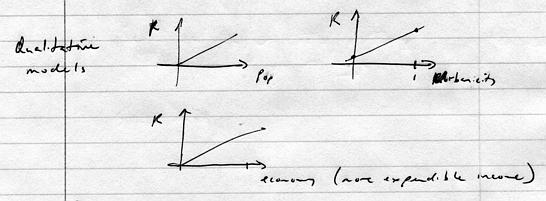The problem is to estimate the number of restaurants in the U.S. Of course, it's hard to say exactly what constitutes a restaurant....
I made the assumptions that the number of restaurants as a function of time R(t) is related to many things, including population (P(t)), "urbanicity" (U(t)), economy (E(t)), etc.: Hence I formed a crude model, as
I considered the "marginal models" (that is, each variable alone with number of restaurants) for each variable, and could say little more than that number of restaurants is increasing with each variable:

- as the population increases,
- as the population becomes more urban, and
- as the economy improved (people have more expendable income)
Because of a resource constraint (limited amount of time to treat this problem!), I simplified my model to make it tractable:
I assumed that the number of restaurants grows linearly with population.
- estimate K, and
- get population data (from http://www.infoplease.com/ipa/A0004997.html).
1990 248,709,873 1980 226,545,805 1970 203,302,031I got a 2000 estimate from http://www.census.gov/population/estimates/nation/intfile1-1.txt:
2000 276,059,000
In order to estimate K, I used my hometown of Bowling Green, OH, which is a good size and demographic mix (about 30,000, including a university).
From my knowledge of the area, I estimate that there are approximately 50 restaurants in town, or 1 for every 600 people. There are certainly more than 25, and not nearly 100 (I will use these bounds on the number of estimates to get some bound on my guess).
Hence, I estimate that
in the U.S., and thus get estimates of
2000 460098 1990 414516for the number of restaurants. Since my K could be wrong by a factor of 2 in either direction (two times too big, two times too small), my estimate could also double or be cut in half.
According to this source, I certainly appear to be in the ballpark:
From http://bubl.a c.uk/journals/agr/jniramd/v01n0295.htm:
Quality Standards and Consumer Satisfaction of Restaurant Dining (Part II)
by Lou-Hon Sun................................................59-80
Abstract: The competitive environment of foodservice industry is
increasingly hostile. Thousands of restaurants have closed in the past few
years. More startling, the total number of U.S. outlets has been sliding
from a peak of 379,000 in 1989 to about 269,000 in 1992 according to
Restaurant Consulting Group Inc. in Evanston, Ill. White-tablecloth
restaurants and independent operators have been hit hardest, but no segment
of the industry has escaped the pain (Therrien, 1992).
Service plays an important role in determining good value at restaurants,
according to National Restaurant Association data ("Service Crows," 1991).
Theoretical and empirical evidence shows that firms that provide higher
levels of service reap higher profits than those that do not (Oliva,
Oliver, & Macmillan, 1992). The Yankelovich Monitor, an annual survey of
consumers, reported that among seven service industries, only supermarkets
have improved the perceived quality of the service in recent years. The
perceived quality of restaurant service remained the same (Daniel, 1992).
Improving service quality to satisfy consumers became a critical issue for
the success of restaurants.
This source shows, however, that it is not sufficient to consider only
population: the population did not fall precipitously in the years between 1989
and 1992, but the economy turned down: did this have a very dramatic impact on
the restaurant industry?
The effect of Urbanicity may appear very gradually, as the demographics of the U.S. are not changing dramatically in that sense (unless we look over the course of decades, as the family farm declined, etc.).
You always say, at the end of such a modeling "project", the following: "more research is needed", hoping that someone will fund you...!